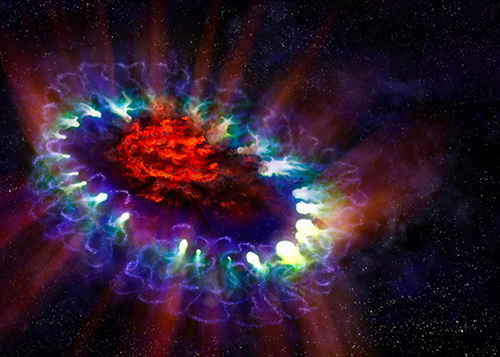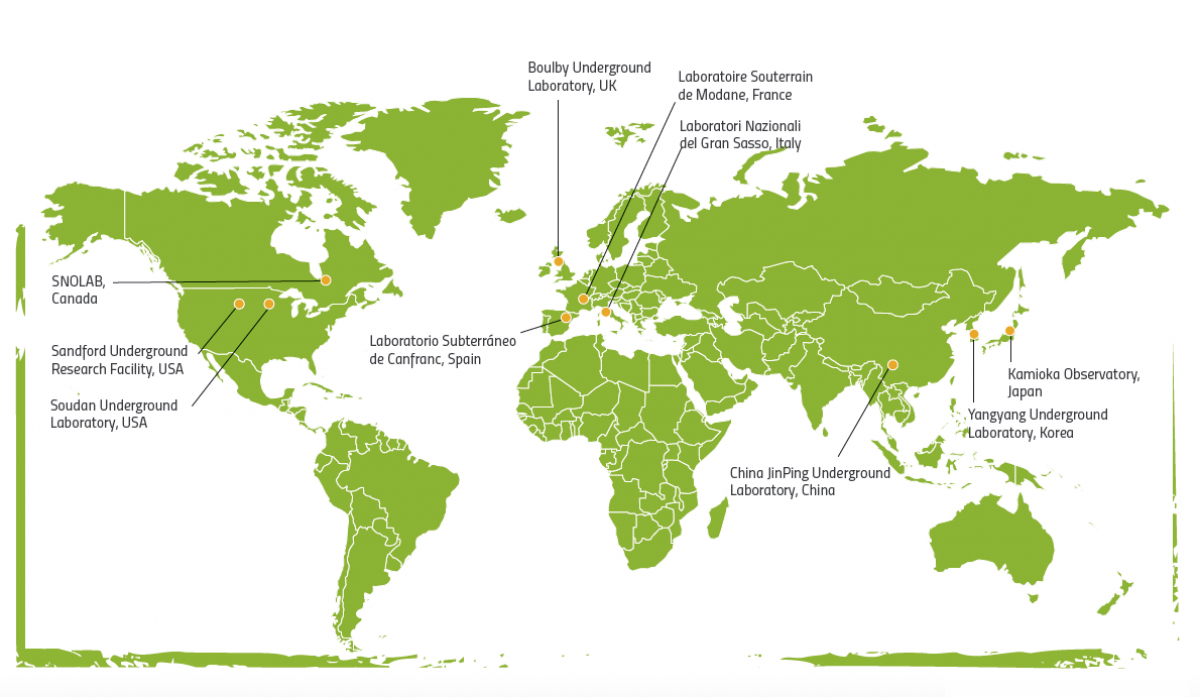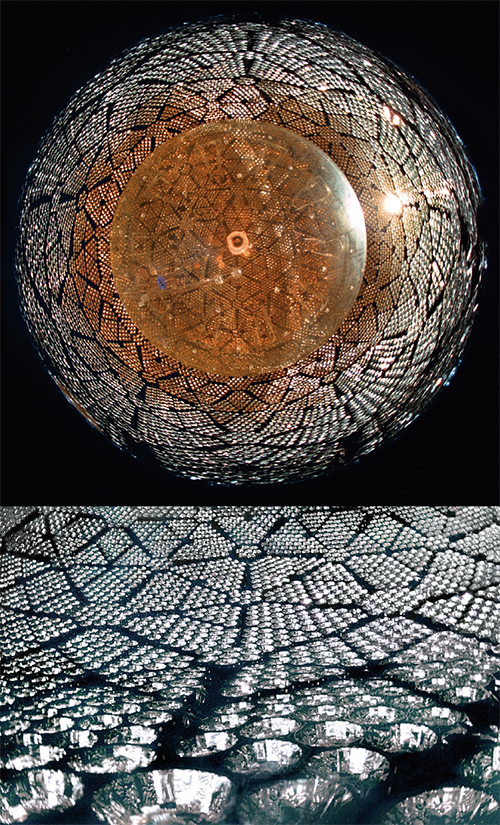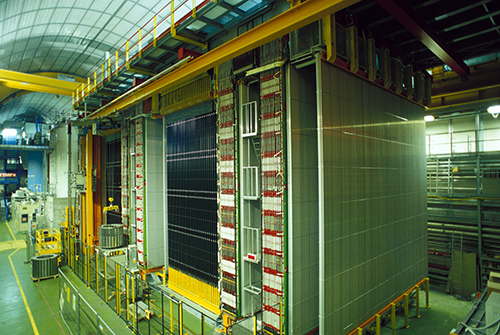Science goes underground Understand article
Scientists are searching deep underground for hard-to-detect particles that stream across the Universe.

Supernova 1987A
Image courtesy of UCL
Mathematical and Physical
Sciences; image source: Flickr
Imagine you are in a noisy, crowded street in the heart of a big city. A bird, perched high up, chirps – but would you hear it? Probably not: it would be hard to pick out the bird’s song from the sounds all around you – cars, machines, people’s voices and so on. Scientists have a similar problem when they are trying to detect particles from space that have travelled to Earth: the weak signals from these ‘astroparticles’ are completely masked by stronger signals from other sources, such as environmental radioactivity.
You might expect that a good way to overcome this problem would be to position astroparticle detectors at high altitudes, but in fact the opposite can be very effective too: the best place for detecting some astroparticles is actually deep underground. This is because the hundreds of metres of rock above help to cut out the unwanted ‘noise’ at Earth’s surface.
But why are scientists interested in astroparticles anyway? These elementary particles of astronomical origin are produced in stars (such as the Sun), in supernova explosions and in even more exotic phenomena such as gamma-ray bursts. Often called messengers of the Universe, astroparticles provide information about events hugely distant in time and space – including the Big Bang itself.
Working underground
There are about 10 deep underground laboratories in the world, all of which are devoted primarily to hunting for astroparticles (Bettini, 2012). Working at this type of facility can be hard. To access laboratories located in mines, a journey in a lift cage is needed, with coming and going timed to fit in with the miners’ shifts; work must therefore be very carefully programmed. In the clean areas, humidity and temperature are closely regulated, so workers need to take a shower and change their clothes before entering. And, of course, there are no windows to let in the sunshine.
The world’s underground laboratories
This map shows the location of some of the most relevant deep underground facilities around the world. There are also similar underground facilities in Finland, Japan, Russia, Ukraine and the USA, and there are plans to build new ones in Australia, India and South America.
- Laboratori Nazionali del Gran Sasso (LNGS), the world’s largest underground laboratory, is located in a highway tunnel 120 km from Rome, Italy.
- Three other mid-size underground laboratories have been active in Europe since the 1980s: Boulby Laboratory on the north-east coast of England, UK; Modane Laboratory in the French Alps; and Canfranc Laboratory under the Spanish Pyrenees.
- Sandford Underground Research Facility was built in a former gold mine in South Dakota, USA. This pioneer underground laboratory was where the first studies of solar neutrinos were carried out in the 1960s (Rosen, 2006).
- SNOlab (Sudbury Neutrino Observatory), near Sudbury in Ontario, Canada, is located in a working nickel mine. The laboratory is one of the deepest in the world, at 2100 m below ground.
- JinPing Laboratory in located within the tunnels of a hydroelectric power company in Sichuan province, China. At 2400 m beneath JinPing mountain, it is the world record holder for depth beneath the Earth’s surface.
- Kamioka Laboratory in Kamioka-cho, Gifu, Japan, has the world’s largest underground neutrino detector. Groundbreaking neutrino experiments have been carried out at this lab over the past two decades.

Image courtesy of Susana Cebrián
The hunt for elusive particles
Many underground laboratories currently focus on hunting for the most elusive type of materials: neutrino particles and dark matter. While these are both abundant in the Universe, they have such weak interactions with ‘normal’ matter that they are impossible to detect in the outside world, and only very rarely underground.
Neutrinos: very important particles
Neutrinos are the second most numerous particle in the Universe (after photons – particles of light). Every square centimetre of Earth’s surface is hit by 1011 neutrinos every second, most of which arrive from the Sun.

sensitive light sensors are
attached to the sphere of the
SNOlab neutrino detector.
Image courtesy of Lawrence
Berkeley Nat’l Lab – Roy
Kaltschmidt; image source:
Flickr
Neutrinos are produced in stars and within nuclear reactors, and are also found in cosmic rays. Sometimes called ‘ghost particles’, they rarely interact with matter and just pass straight through – so despite their vast numbers, detecting neutrinos is extremely challenging. For instance, only a few neutrino detections per month are usually expected, even using enormous detectors. Neutrinos are potentially very important messengers, however, because they can travel without hindrance across the Universe, through places from which no other particles can escape – such as black holes, which trap even light. As they do so, they bring with them valuable information.
In 1987, some underground observatories were amazed to register several neutrinos in just a few seconds; they had witnessed the neutrino signal from supernova 1987A, in the Large Magellanic Cloud (Nakahata, 2007). As 99% of the energy liberated in a supernova is thought to be radiated away in the form of neutrinos, their detection provided much information about what actually happens when a star collapses. Neutrinos produced by radioactive beta decays within Earth have also been detected: these geoneutrinos could become a priceless tool for geophysics (Bellini et al., 2011), as they provide information about the size and location of radioactive sources within Earth’s interior, where access is completely impossible.
Neutrinos from the Sun puzzled scientists for several decades. The number of neutrinos detected overall was much lower than scientists expected the Sun to produce, based on detailed calculations of nuclear fusion processes. The problem was solved in 2001 when it was found that neutrinos, which exist in three types called ‘flavours’, can flip from one type to another in a process called neutrino oscillation (Jelley & Poon, 2007). This is as if you throw an apple to someone – who catches it as an orange or a pear. The puzzle originated because the first experiments measured only one type of neutrino (the ‘apples’) – the form in which solar neutrinos are produced, but any neutrinos that flipped to another type were not detected.
This effect has also been observed in neutrinos from other sources, such as cosmic rays, nuclear reactors and research facilities. In 2015, the Nobel Prize in Physicsw1 was awarded to Takaaki Kajita and Arthur McDonald for their work on neutrino oscillations in Kamioka laboratory (Japan) and SNOlab (Canada).
Neutrino oscillation is important in another way: it confirms that neutrinos have some mass. This is because, as quantum mechanics tells us, such oscillations can only happen if particles have non-zero mass. Observing this in neutrinos was the first evidence of a flaw in the successful ‘standard model’ of particle physics.
The mystery of dark matter
Despite impressive achievements in cosmology, astrophysics and particle physics in recent years, the composition of most of the Universe is still a mystery. One-quarter of the Universe is thought to be made of ‘dark matter’ – so called because it neither emits nor absorbs electromagnetic radiation (including light, radio waves and X-rays). For this reason, dark matter has not yet been detected, despite the huge amount thought to exist. Dark-matter interactions are expected to be extremely rare: just a few events per year in a very large underground detector. There have been positive hints, like those observed by the DAMA / LIBRA experiment in the Gran Sasso laboratory – but no direct detection as yet, so efforts continue (Reich, 2013; Livio & Silk, 2014).

Image courtesy of Francesco Arneodo
Science in the subterranean domain
Particle astrophysics is the main focus for underground laboratories, but their unique features mean they are increasingly used in other areas of science as well. Biologists use them to investigate how micro-organisms can survive in the extreme conditions deep underground, and long-term precision measurements are now carried out for seismology, hydrology and geodynamics. Even space technologies developed for the exploration of Mars are being tested underground, at the Boulby Laboratory (UK), exploiting the similarities between the environments below the surface of Mars and in the deep, rock-salt caverns of the Boulby mine. So while the cosmic silence found deep underground is helping to improve our understanding of the distant reaches of the Universe – its origin, composition and final fate – these special laboratories are also allowing us to study, close up, other worlds deep beneath our feet.
References
- Bellini G et al. (2011) Looking into the Earth’s interior with geo-neutrinos. CERN Courier 51(3): 19-22
- Bettini A (2012) The world deep underground laboratories. European Physics Journal Plus 127: 114
- Jelley N, Poon A (2007) SNO: solving the mystery of the missing neutrinos. CERN Courier 47(4): 26-28
- Livio M, Silk J (2014) Broaden the search for dark matter. Nature 507: 29-31
- Nakahata N (2007) SN1987A heralds the start of neutrino astronomy. CERN Courier 47(1): 23-24
- Reich ES (2013) Dark-matter hunt gets deep. Nature 494:
- Rosen SP (2006) Ray Davis: indefatigable neutrino pioneer. CERN Courier 46(7): 32-34
Web References
- w1 – Learn more about the work that won Takaaki Kajita and Arthur McDonald the 2015 Nobel Prize in Physics.
Resources
- To discover what work at a subterranean laboratory is like, watch the video ‘A day at SNOlab’.
- To learn more about the main underground laboratories in America, Asia and Europe, visit their websites:
- Boulby Underground Laboratory, UK.
- China JinPing underground Laboratory (CJPL), China.
- Kamioka Observatory, Japan.
- Laboratoire Souterrain de Modane (LSM), France.
- Laboratori Nazionali del Gran Sasso (LNGS), Italy.
- Laboratorio Subterráneo de Canfranc (LSC), Spain.
- Sanford Underground Research Facility, USA.
- SNOlab, Canada.
- Yangyang Underground Laboratory, Korea.
- The ASPERA European network for astroparticle physics provides an outreach website.
- Visit the Physics World website for a video in which Arthur McDonald, 2015 Nobel laureate in physics, explains why physicists do experiments deep underground.
- To learn more about neutrinos and the standard model of particle physics, see:
- Piergrossi J (2013) Neutrinos, the standard model misfits. Symmetry Feb 2013.
- ‘Beyond the standard model’
- To find out more about the different areas of subterranean science, see:
- Paling S, Sadler S (2015) Subterranean science. Physics World May 2015
- To learn more about dark matter, see:
- Cebrián S (2011) Neutrinos: an introduction. Science in School 19:55-61-
- Westra MT (2006) Fusion in the Universe: the power of the Sun Science in School 3:60-62.
- Landua R, Rau M (2008) The LHC: a step closer to the Big Bang. Science in School 10: 26-33.
Review
This article is a must-read as it sheds light on the properties of neutrinos and the valuable information that scientists obtain by studying these particles from sites deep underground. The article highlights the fact that there is still so much left to be discovered within particle physics.
The article can be used as a comprehension exercise about some of the properties of the neutrino itself, and what studying neutrinos can reveal about our universe. It can also be used as an introductory article to trigger the curiosity of educators and students alike, and prompt more research about the subject.
Questions on the topic could include:
- What information is currently available about the properties of neutrinos?
- Why are neutrinos being researched in underground laboratories?
- Where and how are neutrinos produced?
- What are the three types of neutrinos, and what is interesting about them?
Catherine Cutajar, St Martin’s College, Malta





